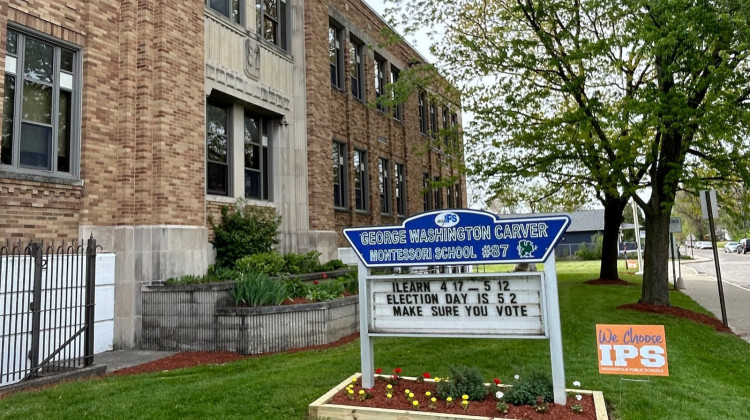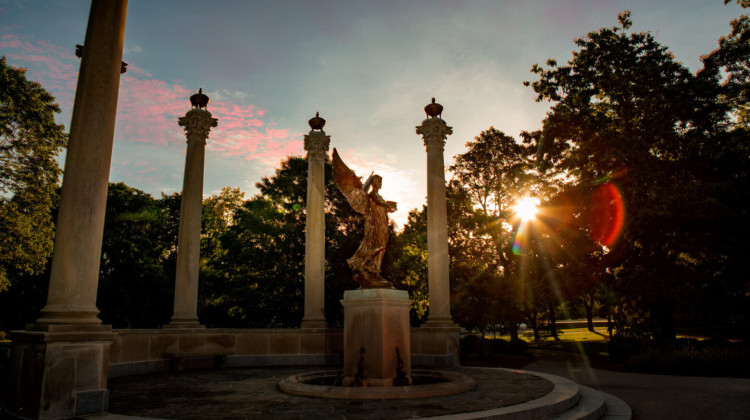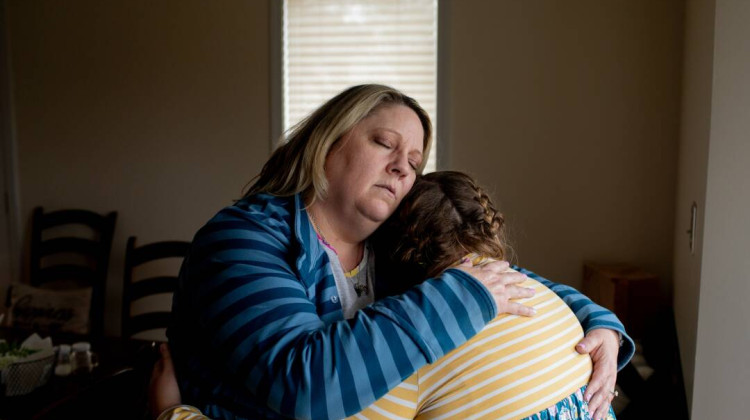
Students eat lunch at the Oaks Academy Middle School, a private Christian school that is integrated by design.
Photo by Dylan Peers McCoyIt’s a rarity in a country where even the most diverse schools are often socially divided, with white children sitting on one side of the cafeteria and black children sitting on the other.
But parents and students say that The Oaks Academy, a private, K-8 Christian school with three campuses in Indianapolis, has managed to achieve what few schools do.
Lunch at The Oaks Middle School on the northeast side of Indianapolis has a lot in common with meals at any school: Kids carry plastic trays stacked with sliced fruit and chicken nuggets or soft lunch bags stuffed with sandwiches and Doritos. But here, as the hum of chatter and banging of metal chairs fill the small cafeteria, kids head to tables with students from different ethnic and racial backgrounds.
“I just love the fact that when you come to the lunchroom, everybody is sitting by everybody,” Hogue said. Hogue, who is African-American, has two daughters at the Brookside elementary school campus of The Oaks. “As a minority man … I wanted my children to be around everyone.”
The blending of students in the lunchroom is no accident.
At a time when many public and private schools are segregated by race and class — and even racially mixed schools are often accidents of shifting residential patterns — The Oaks was intentionally designed to include students of different races and economic classes.
Not every school can precisely emulate The Oaks, since its leaders, and many parents, believe the school is defined by its Christian values. But its remarkable capacity to attract diverse families and create a community where students feel at ease and form friendships across often intractable social divides offers insight for schools across a still-divided city.
The school’s three campuses are set in low-income, heavily black, urban neighborhoods. But the aim of the school has always been to serve not only the children of those neighborhoods but also families that had migrated to the suburbs, said Andrew Hart, CEO of The Oaks schools.
“The origin of the idea of The Oaks was — ‘Let’s start a school that provides an education of such quality that families will pull their kids up from the finest, most elite private or suburban schools,’ ” said Hart, who started volunteering at the school in its early years. “But also let’s actively serve and reach out to neighborhood children.”
The formula for drawing diverse families to The Oaks is working. At the three campuses, about 52 percent of students are white, 34 percent are black and 14 percent are Hispanic, multiracial or Asian, according to state data. About a third of kids come from families that are poor enough to qualify for meal assistance.
The Oaks also has consistently stellar state test scores. Last year, it was the top-scoring network of schools on Indiana’s ISTEP exams.
In a year when just 54 percent of kids passed the test statewide, 83 percent of Oaks students passed. Students at the relatively diverse, urban Oaks campuses outscored their peers in affluent, mostly white suburbs such as Carmel and Zionsville. For poor and black kids, the strong test results are particularly exceptional.
Hart believes that the unique mix of children with different backgrounds is a key factor in bolstering their academic success.
“Receiving a great education is not just about information transfer — it’s about relationships,” he said. “Being successful in the world is about learning to build relationships with people that may be different than yourself.”
The model for integrating The Oaks is similar to the strategy used by many public magnet schools, which were originally envisioned as catalysts for integration. The idea is that placing schools in a low-income, usually black or Hispanic neighborhood, then offering a specialized education program that attracts white, suburban families, will create voluntary integration.
But in Indianapolis, magnet schools have evolved into more of a tool for promoting specialized curricula instead of aiding integration. Few Indianapolis Public Schools magnets successfully bring together kids from different neighborhoods, and some even exacerbate segregation through rules that prioritize students in their immediate vicinity.
The success of The Oaks, however, demonstrates that it is possible to convince affluent families to send their children to diverse, urban schools.
Students at The Oaks have widely different preparation outside school — some have educated, stay-at-home parents. Others grapple with instability, even homelessness. Like most schools, The Oaks sees lower ISTEP pass rates for its poor and black kids than it does for more affluent students. Last year, 72 percent of black students passed the test, compared with 91 percent of white students.
But the test score gap is much smaller between the two groups at The Oaks than at other schools across the state, where black students’ passing rate is 31 percentage points below that of their white peers.
Hart credits the high scores at the schools to a wide variety of strategies, from small class sizes to investment in early education. But committed parents and educators are the backbone of the academic success at The Oaks, Hart said. More than 90 percent of students typically return each year, allowing the school to emphasize behavior in the early grades so that students can focus on academics in later years.
Elijah Cummins, who recently completed the eighth grade at The Oaks, said he learned about the school from the tutors he worked with when he was struggling in first grade at IPS School 60 — at the time one of the lowest-scoring neighborhood schools in the city. Academics can still be hard for him, but now he sees his challenges differently.
“It’s a little hard, but for algebra it should be hard,” said Elijah, who considers math his favorite class. “I feel like our teacher makes it easy to understand.”

In some ways, it’s not surprising that poor and black students have better test scores when they attend integrated schools like The Oaks. Decades of research demonstrate that poor children perform significantly better when they attend schools that are largely middle class — schools with advantages such as well-prepared peers, engaged parents and high expectations from teachers.
The surprising success at The Oaks is the school’s ability to attract such a diverse group of families.
The Oaks was founded by congregants from Tabernacle Presbyterian Church who aimed to revitalize urban neighborhoods, Hart said. When the church opened a school in Fall Creek in 1998, the Oaks had just 52 students, and it was something of an experiment.
But even at that point, it was drawing in families who were black, white, rich and poor, Hart said. In the years since, it has largely attracted new students by word-of-mouth. Because the school has a fairly balanced enrollment, the new families who learn about the school also come from black and white communities.
The full sticker price for The Oaks is up to $10,110 per year, but low-income students at The Oaks typically receive financial aid from the school as well as tuition vouchers from the state, so they may pay as little as $500 per year in tuition and fees, Hart said. According to state data, 354 students at The Oaks received vouchers last year — just over half the enrollment.
Partly because of the voucher program, The Oaks was able to open a second elementary school campus and a middle school in recent years. Both schools are in former IPS buildings in poor areas on the northeast side — just a few blocks away, houses are marked by boarded-up windows. But it continues to draw in families from around the city.
Like many parents at The Oaks, Ken Yoder and his family live near good public schools in Franklin Township. If they’d never learned about The Oaks, he and his wife, Elizabeth, probably would’ve sent their four daughters to the highest-scoring township school district in Marion County — a suburban district that is also 76 percent white.
But when the Yoders learned about The Oaks from a friend, they were immediately intrigued by the idea of a diverse, Christian school.
Now, Elizabeth drives more than two hours each day to take two of their daughters to The Oaks Brookside campus.
“We want our girls to grow up with just kind of a normal sense of diversity and appreciation of diversity,” Ken Yoder said.

To maintain an integrated school, The Oaks needs to attract not only low-income families from the neighborhood, but also middle-class families with many other options. The schools use a classical curriculum that incorporates requirements such as Latin. But ask parents and educators why they were drawn to The Oaks and they often focus on something else: the culture, the community and the Christian values at the schools.
“Having a small community helps you get to know everyone,” said middle schooler Grace Brenner. “Once you just get to know everyone, that helps you be friends with everyone.”
Students say that spending years with the same students and families helps build the community at the school — where kids make friends across class and racial divides.
Before Elijah Cummins transferred to The Oaks in second grade, he was at a school with lots of low-income kids. But even as a first-grader, he felt like an outsider. He didn’t own “cool things,” he said, and he was beaten up by older kids, sometimes coming home with a bloody nose.
At The Oaks, Elijah said, his outlook has changed. Instead of feeling embittered, he carries a sheet of paper for writing down jokes. Although there’s a financial gulf between Elijah and some of the more affluent students, he feels completely at home at the school, he said.
“I feel like everyone here is family almost, and I just really love everyone that’s here — the teachers, the students, the building,” he said. “I’m now the guy who changes all my anger into comedy.”
Chalkbeat is a nonprofit news site covering educational change in public schools.
 DONATE
DONATE









 Support WFYI. We can't do it without you.
Support WFYI. We can't do it without you.